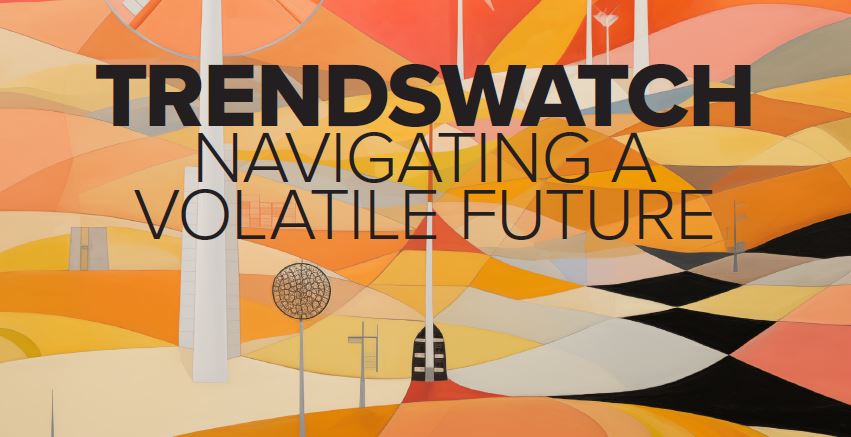
It’s that time again! Check your mailbox for the 2024 edition of TrendsWatch, AAM’s annual forecasting report.
Starting last year, we began publishing TrendsWatch as the Jan/Feb edition of Museum magazine. I am so pleased with this integration: the report has wider distribution, and the majority of readers have access to a physical AND a digital copy. People who support production of the report through their AAM membership receive earliest access to the content, and it is available free to all (including students, press, and people outside the museum sector) as a PDF released in March (which is when the report used to appear each year). Not a member and itching to read the content? If you join now, you can access a digital copy of the report via the AAM website, as well as the individual articles.
The 2024 Topics
This year the report dives into:
Culture Wars 2.0
Last year TrendsWatch examined the growing partisan divide in the U.S. and how museums might help repair our fractured democracy. However, an adjacent trend threatens the sectors’ ability to fill this reparative role: museums as battlegrounds in a new wave of culture wars. Some are criticizing museums for embracing progressive values, while others regard museums as conservative vestiges of a colonial past. With alarming frequency, climate activists use museums as stages for protest or vandalism to draw attention their cause. Pressure is building along fault lines that segment communities, funders, policy makers, and museums’ own staff, boards, and volunteers. How can museums defuse this tension before it causes more damage? What choices do they face, in avoiding or engaging in the current conflict, and how will these choices shape the future of museums and society?
AI Adolescence
In the past decade, artificial intelligence (AI) has leapt from the realm of science fiction and tech culture into our everyday lives. Most recently, generative AI is disrupting the work of creators, upending education, and performing key tasks in white collar work. Some feel AI poses an existential threat to humanity–others forecast that it will quickly retreat into specific, narrow applications. What is AI, is the hype justified, and how can museums make informed judgements about this or any other emerging technology? What are the practical applications and implications for museums in the short and long term?
Decarbonizing the Future
The climate crisis poses an overwhelming threat to museums, the communities museums serve, and the material legacy of all humans have accomplished. Museums’ collections constitute a vast seedbank of human civilization, creativity, and accomplishments. Protecting those seeds will entail a commitment to decarbonizing the future—replacing our dependance on fossil fuels with sustainable systems. How can museums decarbonize their own operations? How can they inspire people to take meaningful action in response to the climate crisis, even as they prepare to live in a profoundly disrupted future?
I also take a quick look at the emerging practice of dropping degree requirements from position postings, and flag Surgeon General Vivek Murthy’s report on the growing loneliness epidemic for your attention. Check out this year’s trending vocabulary terms –”doom loops” and “digital twins”—to spark your coffee break conversations.
I’ve started a discussion around the report on the Museum Junction Future of Museums Community—I hope you will weigh in to share how these issues are impacting your life, your museum, and your community.
This Year’s Theme: Volatility
As I explain in the introduction* to the report, this year’s unifying theme is volatility—strategic foresight parlance for the speed of change. That speed has been increasing exponentially in recent decades. Google’s director of engineering recently predicted that by 2041, we will be experiencing a year of change (by today’s standards) in three months, and by 2071, a year of change in 11 days. That’s the equivalent of 33 years of change in one year! The past 33 years gave us the World Wide Web, email, personal computers, and smartphones; we mapped the human genome and discovered how to edit individual genes. What will it be like to live through that amount of change in just one year? How can we make plans that can survive such rapid transformations?
*The full introduction to the report is publicly accessible, and includes an explanation of how the report is created, and suggestions for using it in your work.
On one hand, speed can be exhilarating. Open AI’s ChatGPT launched in November 2022; by January 2023 it had 100 million active monthly global users. The user base is projected to grow to 117 million in the US alone by 2025. The technology is amazing: it empowers anyone to be an artist or a writer. It helps students apply to college, journalists draft stories, and architects model the mechanics of their creations. People hope it will make legal services more affordable, education more effective, and brain surgery more accurate. On the surface, generative AI (GenAI) seems like another example of triumphant progress, promising to improve our lives as profoundly as penicillin.
But volatility has another connotation as well, not just rapid but also unpredictable change, often for the worse. It may be thrilling to go fast, but the prospect of rocketing into the future at warp speed, veering erratically, bouncing off obstacles, is terrifying. GenAI is already disrupting whole industries, competing with illustrators, writers, and journalists and displacing 4,000 jobs a month. Goldman Sachs estimates that globally, 300 million current jobs are at risk of being automated by AI. In October 2023, the head of the Securities and Exchange Commission, testifying before the House Financial Services Committee, warned that, absent regulation, it is “nearly unavoidable” that AI will cause a massive financial crisis in the next decade. But that regulation will be hard to implement since the SEC is designed to oversee individual organizations and brokers, not the underlying systems, including AI algorithms, on which these entities rely. Creating effective guardrails for emerging technologies may require us to fundamentally reshape our regulatory infrastructure.
That’s a second, underlying theme of this report: the need to reexamine and reinvent a lot of systems that shape our lives, systems that may have worked more or less well for a couple hundred years but now teeter on the edge of failure. Technology, combined with cultural, environmental, and financial stressors, has widened the partisan divide to the point where approximately 40 percent of all voters, Republican and Democrat, believe that the other side is so extreme that it would be OK to use violence to prevent them from achieving their goals. The same study found a significant share of respondents expressing doubts about the future of democracy and even the United States as it is currently composed. Will we need to reform our civic infrastructure if democracy is to survive?
Emissions from over 200 years of reliance on fossil fuels have resulted in temperatures increasing more in the past 50 years than any 50-year period in the past two millennia. This astounding rate of change challenges our ability to respond: we have been unable to invent, test, and implement solutions fast enough to keep global CO2 below critical levels. At the same time, we have to deal with the literal volatility of the climate crisis. Last year was the hottest on record, with four months in a row of record-breaking temperatures and the skies blanketed by the smoke of nearly 46 million acres burning across Canada—nine times the historical average. While some believe that technology can save us, it’s clear that even with the best technologies, we will need to eat less meat, travel less often, and take up less space (in our homes and on the planet) to stick to a strict carbon diet.
Does all this seem intimidating? It does to me. One comforting thought: humans are supremely adaptable to change. Our great grandparents may have been terrified to hurtle down the highway at 75 mph—now we are so blasé about that speed we have to be reminded to keep both hands on the wheel (and thumbs off our phones). So maybe by the time humans reach 33 years of change in one year, this volatility will seem normal.
Another important thing to keep in mind: while some of this acceleration is beyond the control of any one individual, organization, or country, there are things we can do to apply the brakes. We can take the time to savor the process of putting words on paper rather than using AI to generate our correspondence. We can choose to challenge the supremacy of efficiency and value the benefits of measured, thoughtful collaboration. Museums, as cultural influencers, can offer their communities a place to slow down and decompress. They can ally with the movements promoting slow art, slow tourism, and slow food. And we can remind each other that we don’t have to go fast just because we can.
In the face of a volatile future, it’s critical to cultivate what Dr. Jane McGonigal, of the Institute for the Future, calls “urgent optimism”: the desire to act immediately to tackle an obstacle, combined with the belief that we have a reasonable hope of success. I hope this report will foster that hope and leave you feeling empowered to make a difference.
Yours from the future,

Elizabeth Merritt
Vice President, Strategic Foresight and Founding Director, Center for the Future of Museums
American Alliance of Museums









